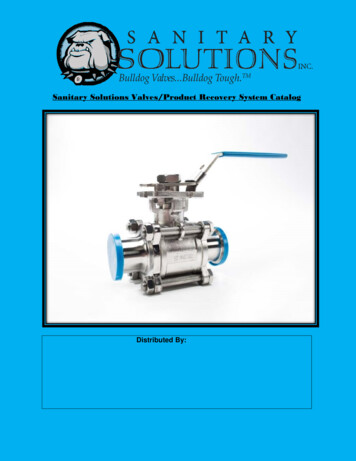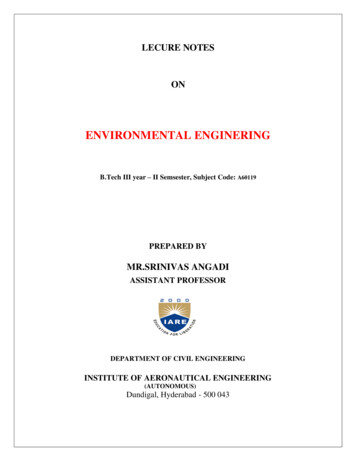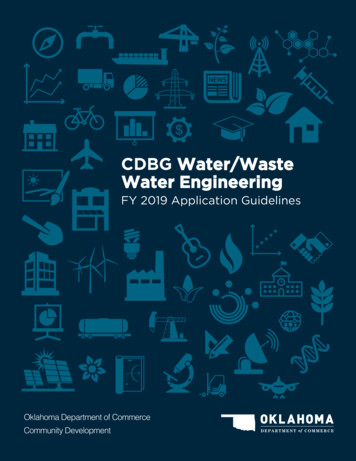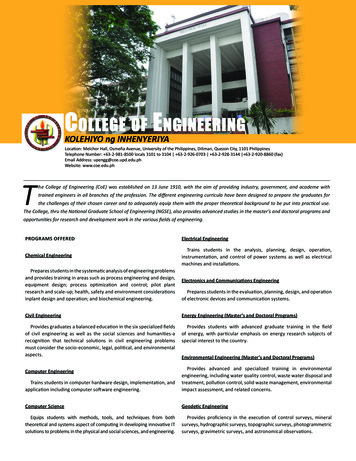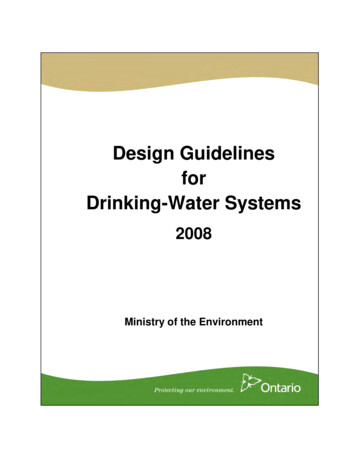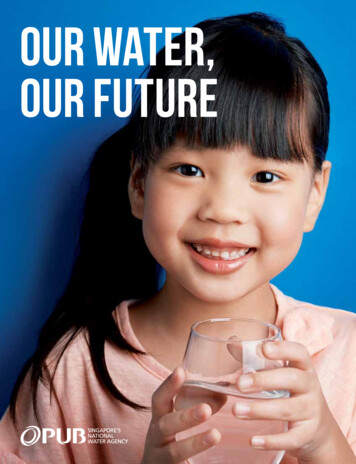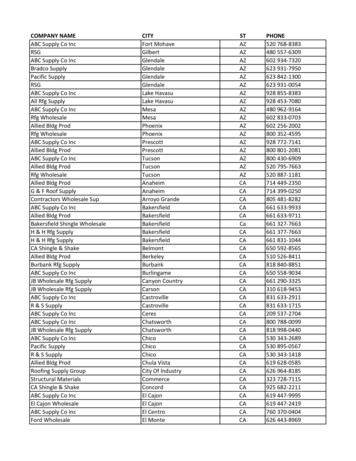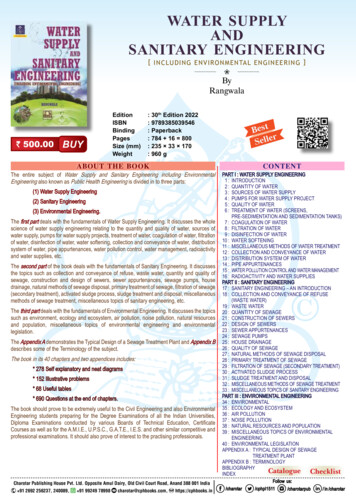
Transcription
WATER SUPPLYANDSANITARY ENGINEERING[ I NC L U D I NG EN V I R O N M ENTAL EN G I N EER I N G ] ByRangwala 500.00BUYEditionISBNBindingPagesSize (mm)Weight: 30th Edition 2022: 9789385039546: Paperback: 784 16 800: 235 33 170: 960 gBestrSelleABOUT THE BOOKThe entire subject of Water Supply and Sanitary Engineering including EnvironmentalEngineering also known as Public Health Engineering is divided in to three parts:(1) Water Supply Engineering(2) Sanitary Engineering(3) Environmental Engineering.The first part deals with the fundamentals of Water Supply Engineering. It discusses the wholescience of water supply engineering relating to the quantity and quality of water, sources ofwater supply, pumps for water supply projects, treatment of water, coagulation of water, filtrationof water, disinfection of water, water softening, collection and conveyance of water, distributionsystem of water, pipe appurtenances, water pollution control, water management, radioactivityand water supplies, etc.The second part of the book deals with the fundamentals of Sanitary Engineering. It discussesthe topics such as collection and conveyance of refuse, waste water, quantity and quality ofsewage, construction and design of sewers, sewer appurtenances, sewage pumps, housedrainage, natural methods of sewage disposal, primary treatment of sewage, filtration of sewage(secondary treatment), activated sludge process, sludge treatment and disposal, miscellaneousmethods of sewage treatment, miscellaneous topics of sanitary engineering, etc.The third part deals with the fundamentals of Environmental Engineering. It discusses the topicssuch as environment, ecology and ecosystem, air pollution, noise pollution, natural resourcesand population, miscellaneous topics of environmental engineering and environmentallegislation.The Appendix A demonstrates the Typical Design of a Sewage Treatment Plant and Appendix Bdescribes some of the Terminology of the subject.The book in its 40 chapters and two appendices includes:* 278 Self explanatory and neat diagrams* 152 Illustrative problems* 68 Useful tables* 690 Questions at the end of chapters.The book should prove to be extremely useful to the Civil Engineering and also EnvironmentalEngineering students preparing for the Degree Examinations of all the Indian Universities,Diploma Examinations conducted by various Boards of Technical Education, CertificateCourses as well as for the A.M.I.E., U.P.S.C., G.A.T.E., I.E.S. and other similar competitive andprofessional examinations. It should also prove of interest to the practising professionals.Charotar Publishing House Pvt. Ltd. Opposite Amul Dairy, Old Civil Court Road, Anand 388 001 India 91 2692 256237, 240089, 91 99249 ENTPART I : WATER SUPPLY ENGINEERING1 : INTRODUCTION2 : QUANTITY OF WATER3 : SOURCES OF WATER SUPPLY4 : PUMPS FOR WATER SUPPLY PROJECT5 : QUALITY OF WATER6 : TREATMENT OF WATER (SCREENS,PRE-SEDIMENTATION AND SEDIMENTATION TANKS)7 : COAGULATION OF WATER8 : FILTRATION OF WATER9 : DISINFECTION OF WATER10 : WATER SOFTENING11 : MISCELLANEOUS METHODS OF WATER TREATMENT12 : COLLECTION AND CONVEYANCE OF WATER13 : DISTRIBUTION SYSTEM OF WATER14 : PIPE APPURTENANCES15 : WATER POLLUTION CONTROL AND WATER MANAGEMENT16 : RADIOACTIVITY AND WATER SUPPLIESPART II : SANITARY ENGINEERING17 : SANITARY ENGINEERING – AN INTRODUCTION18 : COLLECTION AND CONVEYANCE OF REFUSE(WASTE WATER)19 : WASTE WATER20 : QUANTITY OF SEWAGE21 : CONSTRUCTION OF SEWERS22 : DESIGN OF SEWERS23 : SEWER APPURTENANCES24 : SEWAGE PUMPS25 : HOUSE DRAINAGE26 : QUALITY OF SEWAGE27 : NATURAL METHODS OF SEWAGE DISPOSAL28 : PRIMARY TREATMENT OF SEWAGE29 : FILTRATION OF SEWAGE (SECONDARY TREATMENT)30 : ACTIVATED SLUDGE PROCESS31 : SLUDGE TREATMENT AND DISPOSAL32 : MISCELLANEOUS METHODS OF SEWAGE TREATMENT33 : MISCELLANEOUS TOPICS OF SANITARY ENGINEERINGPART III : ENVIRONMENTAL ENGINEERING34 : ENVIRONMENTAL35 : ECOLOGY AND ECOSYSTEM36 : AIR POLLUTION37 : NOISE POLLUTION38 : NATURAL RESOURCES AND POPULATION39 : MISCELLANEOUS TOPICS OF ENVIRONMENTALENGINEERING40 : ENVIRONMENTAL LEGISLATIONAPPENDIX A : TYPICAL DESIGN OF SEWAGETREATMENT PLANTAPPENDIX B : TERMINOLOGYBIBLIOGRAPHYCatalogue ChecklistINDEXFollow us:/charotar/cphpl1511/charotarpub/ in /charotar
WATER SUPPLY AND SANITARY ENGINEERINGDETAILED CONTENTSPART I : WATER SUPPLY ENGINEERINGChapter 1 INTRODUCTION1-1. General1-2. Need to protect water supplies1-3. Water supply schemes1-4. Project drawings1-5. Report of water supply scheme/project1-6. Importance of water supply project1-7. Layout of water supply projectQUESTIONS 1Chapter 2 QUANTITY OF WATER2-1. Data to be collected2-2. Rate of demand2-3. Factors affecting rate of demand2-4. Measurement of water2-5. Variations in rate of demand2-6. Effects of variations on design2-7. Water requirements for buildings other than residences2-8. Design period2-9. SummaryQUESTIONS 2Chapter 3 SOURCES OF WATER SUPPLY3-1. General3-2. Surface runoff3-3. Precipitation3-4. Measurement of rainfall3-5. Rainfall3-6. Choice of source of water supply scheme3-7. Types of sources for water supply schemes3-8. Surface sources for water supply schemes3-9. Salient features of reservoir design3-10. Underground sources for water supply schemes3-11. Forms of underground sources3-12. Classification of wells3-13. Types of well construction3-14. Yield of a well3-15. Specific capacity of a well3-16. Tests for yield of a well3-17. Spacing of wells3-18. Sanitary protection of wells3-19. Summary3-20. Typical problemsQUESTIONS 3Chapter 4 PUMPS FOR WATER SUPPLY PROJECT4-1. Necessity of pumps4-2. Choice of type of pumps4-3. Types of pumps4-4. Power for pumps4-5. Design of pumps4-6. Rising main4-7. Typical ProblemsQUESTIONS 4Chapter 5 QUALITY OF WATER5-1. Meaning of pure water5-2. Reasons for the analysis of water5-3. Impurities in water5-4. Analysis of water5-5. Physical tests5-6. Chemical tests5-7. Bacteriological tests5-8. Maintenance of purity of waters5-9. Water-borne diseases5-10. Suitability of water for trade purposes:5-11. Water for swimming pools5-12. Drinking water standardsQUESTIONS 5Chapter 6 TREATMENT OF WATER (SCREENS, PRESEDIMENTATION AND SEDIMENTATION TANKS)6-1. General6-2. Screens6-3. Pre-sedimentation6-4. Sedimentation tanks6-4-1. Purpose and location6-4-2. Theory of sedimentation6-4-3. Types of sedimentation tanks6-4-4. Design aspects of continuousQUESTIONS 6Chapter 7 COAGULATION OF WATER7-1. Purpose7-2. Principle of coagulation7-3. Flocculation7-4. Usual coagulants7-5. Feeding the coagulants7-6. Mixing devices7-7. Jar testQUESTIONS 7Chapter 8 FILTRATION OF WATER8-1. General8-2. Theory of filtration8-3. Filter sand8-4. Classification of filters8-4-1. Slow sand filters8-4-2. Gravity type rapid sand filters8-4-3. Pressure type rapid sand filters8-5. Comparison between slow sand filters and gravity type rapidsand filters8-6. Double filtrationQUESTIONS 8Chapter 9 DISINFECTION OF WATER9-1. Necessity for disinfection of water9-2. Theory of disinfection9-3. Minor methods of disinfection9-4. Uses of ULTRA VIOLET–UV system9-5. Chlorination9-6. Properties of chlorine9-7. Action of chlorine9-8. Application of chlorine9-9. Forms of chlorination9-10. Tests for chlorine9-11. Chlorine dioxideQuestions 9Chapter 10 WATER SOFTENING10-1. Purpose of water softening10-2. Types of hardness10-3. Removal of temporary hardness10-4. Removal of permanent hardness10-5. Lime-soda process10-6. Zeolite process10-7. Demineralisation process10-8. Reverse osmosisQUESTIONS 10Chapter 11 MISCELLANEOUS METHODSTREATMENT11-1. General11-2. Colour, odour and taste removal11-3. Iron and manganese removal11-4. FluoridationQUESTIONS 11 91 99249 78998charotar@cphbooks.com,WATERChapter 12 COLLECTION AND CONVEYANCE OF WATER12-1. MeaningCOLLECTION OF WATER12-2. IntakesCharotar Publishing House Pvt. Ltd. Opposite Amul Dairy, Old Civil Court Road, Anand 388 001 India 91 2692 256237, 240089,OFhttps://cphbooks.inFollow us:/charotar/cphpl1511/charotarpub/ in /charotar
WATER SUPPLY AND SANITARY ENGINEERINGDETAILED CONTENTS12-3.12-4.12-5.12-6.Design of intakesDesign procedure for intakesTypes of intakesIntake towersCONVEYANCE OF WATER12-7. Conveyance of water12-8. Pipes12-9. Types of Pipes according to material used12-10. Pipe corrosion12-11. Effects of pipe corrosion12-12. Theories of pipe corrosion12-13. Prevention of pipe corrosion12-14. Laying of water supply pipes12-15. Hydrostatic testing of pipesQUESTIONS 12Chapter 13 DISTRIBUTION SYSTEM OF WATER13-1. General considerations13-2. Methods of distribution of water13-3. Service reservoirs13-4. Systems of supply of water13-5. Methods of layout of distribution pipes13-6. Wastage of water13-7. Water waste surveys13-8. Permissible wastage of water13-9. Preventive measures13-10. Water waste tests13-11. Maintenance of distribution systemQUESTIONS 13Chapter 14 PIPE APPURTENANCES14-1. Necessity14-2. Air valves14-3. Bib cocks14-4. Fire hydrants14-5. Reflux valves14-6. Relief valves14-7. Sluice valves14-8. Scour valves14-9. Stop cocks14-10. Water metersQUESTIONS 14Chapter 15 WATER POLLUTION CONTROL AND WATERMANAGEMENT15-1. Meaning of the term15-2. Sources of water pollution15-3. Types of water pollution15-4. Preventive measures15-5. Conclusion15-6. Water management15-7. Measures for re-shaping local water balance15-8. Use and conservation of water resourcesQUESTIONS 15Chapter 16 RADIOACTIVITY AND WATER SUPPLIES16-1. Radioactivity16-2. Effects of radiation16-3. Radioactive sources16-4. Disposal of radioactive wastes16-5. Radioactivity of water16-6. Measurement of radioactivity16-7. Effect of treatments on water16-8. Recommended methods16-9. ConclusionQUESTIONS 16PART II : SANITARY ENGINEERINGChapter 17 SANITARY ENGINEERING – AN INTRODUCTION17-1. General17-2. Purpose of sanitation17-3. Principles of sanitation17-4. Sanitary projects17-5.17-6.17-7.17-8.17-9.Sanitary project drawingsReport for sanitary projectSite for sewage treatment worksDesign aspects for sewage treatment plant 298Some definitionsQUESTIONS 17Chapter 18 COLLECTION AND CONVEYANCE OF REFUSE(WASTE WATER)18-1. General18-2. Methods of carrying refuse18-3. Systems of sewerage18-4. Favourable Conditions for sewerage18-5. Patterns of refuse collectionQUESTIONS 18Chapter 19 WASTE WATER19-1. General19-2. Standards for disposal of waste water19-3. Waste water treatment19-4. Primary waste water treatment19-5. Secondary waste water treatment19-5-1. Biological treatment units19-5-2. Secondary clarifier19-5-3. Sludge digester19-5-4. Sludge drying beds19-6. Oxidation ponds19-7. Tertiary waste water treatment19-8. Disposal of waste water19-9. Reuses of waste waterQUESTIONS 19Chapter 20 QUANTITY OF SEWAGE20-1. General20-2. Dry weather flow20-3. Storm waterQUESTIONS 20Chapter 21 CONSTRUCTION OF SEWERS21-1. General21-2. Materials for sewers21-3. Materials used for sewers21-4. Shapes of sewers21-5. Joints in sewers21-6. Laying and testing of sewers21-7. Ventilation of sewers21-8. Methods of ventilation of sewers21-9. Cleaning and maintenance of sewers21-10. Surface drainsQUESTIONS 21Chapter 22 DESIGN OF SEWERS22-1. General approach22-2. Minimum and maximum velocities (Self-cleansing and nonscouring velocities)22-3. Hydraulic formulas for design of sewers22-4. Sizes of sewers22-5. Time of concentration22-6. Design procedure22-7. Variation in flow and velocities22-8. Typical Problems of design of sewersQUESTIONS 22Chapter 23 SEWER APPURTENANCES23-1. Meaning of the term23-2. Catch basins or catch pits23-3. Clean-outs23-4. Drop manholes23-5. Flushing tanks23-6. Grease and oil traps23-7. Inlets23-8. Inverted siphons23-9. Lampholes23-10. Manholes23-11. Storm water regulatorsQUESTIONS 23Charotar Publishing House Pvt. Ltd. Opposite Amul Dairy, Old Civil Court Road, Anand 388 001 India 91 2692 256237, 240089, 91 99249 ow us:/charotar/cphpl1511/charotarpub/ in /charotar
WATER SUPPLY AND SANITARY ENGINEERINGDETAILED CONTENTSChapter 24 SEWAGE PUMPS24-1. Necessity of pumps24-2. Pumping of sewage24-3. Pumping stations24-4. Requirements of a pumping station24-5. Types of sewage pumps24-6. Power for pumps24-7Horse-power of pumpsQUESTIONS 24Chapter 25 HOUSE DRAINAGE25-1. Meaning of the term25-2. Principles of house drainage25-3. Traps25-4. Some definitions25-5. Sanitary fittings25-6. Systems of plumbing25-7. Drainage plans of buildings25-8. Testing of drains and pipes25-9. Maintenance of house drainage systemQUESTIONS 25Chapter 26 QUALITY OF SEWAGE26-1. General26-2. Properties of sewage26-2-1. Physical properties26-2-2. Chemical properties26-2-3. Biological properties26-3. Cycles of decomposition26-4. Analysis of sewage26-5. Physical tests26-6. Chemical tests26-6-1. Chlorine26-6-2. Fats, greases and oils26-6-3. Nitrogen26-6-4. Oxygen26-6-5. pH value26-6-6. Total solids26-7. Bacteriological tests26-8Relative stability26-9. Population equivalentQUESTIONS 26Chapter 27 NATURAL METHODS OF SEWAGE DISPOSAL27-1. General27-2. Disposal by dilution27-3. Self-purification of natural waters27-4. Disposal by land treatment27-5. Sewage sicknessQUESTIONS 27Chapter 28 PRIMARY TREATMENT OF SEWAGE28-1. General28-2. Screens28-3. Grit chambers28-4. Detritus tanks28-5. Skimming tanks28-6. Plain sedimentation tanks28-7. Primary clarifiers28-8. Secondary clarifiers28-9. Coagulation of sewageQUESTIONS 28Chapter 29 FILTRATION OF SEWAGE (SECONDARYTREATMENT)29-1. Secondary treatment29-2. Filters29-3. Contact beds29-4. Intermittent sand filters29-5. Trickling filters29-5-1. Standard rate trickling filters29-5-2. High rate or high capacity trickling filters29-6. Miscellaneous filtersQUESTIONS 29Chapter 30 ACTIVATED SLUDGE PROCESS30-1. Meaning of the term30-2. Action of activated sludge30-3. Flow diagram30-4. Methods of aeration30-5. Diffused air aeration30-6. Mechanical aeration30-7. Combination of diffused air aeration and mechanical aeration30-8. Sludge bulking30-9. Accumulation of volatile suspended solids30-10. Sludge volume index30-11. Sludge density index30-12. Step aeration30-13. Tapered aeration30-14. Extended aeration30-15. Contact stabilization30-16. Complete mix process30-17. Oxidation ditch30-18. Advantages of activated sludge process30-19. Disadvantages of activated sludge process30-20. Activated sludge process versus trickling filtersQUESTIONS 30Chapter 31 SLUDGE TREATMENT AND DISPOSAL31-1. Necessity31-2. Quantity of sludge31-3. Sludge treatment31-3-1. Sludge thickening31-3-2. Sludge digestion31-3-3. Sludge conditioning31-3-4. Sludge dewatering31-3-5. Sludge disposal31-4. Sludge gas31-5. Sludge digestion tanks31-6. Capacity of sludge digestion tank31-7. Standard rate digestion31-8. High rate digestion31-9. Two-stage digestionQUESTIONS 31Chapter 32 MISCELLANEOUS METHODS OF SEWAGETREATMENT32-1. General32-2. Cesspools32-3. Chlorination of sewage32-4. Imhoff tanks32-5. Oxidation ponds32-6. Septic tanks32-7. Treatment of industrial wastes32-8. Wastes from fertiliser factoriesQUESTIONS 32Chapter 33 MISCELLANEOUS TOPICS OFENGINEERING33-1. General33-2. Bio-gas33-3. Elutriation33-4. Garbage collection and removal33-5. Garbage disposal33-6. Micro-organisms33-7. Types of metabolism33-8. Divisions of micro-organisms33-9. Night soil disposal without water carriage33-10. Rural sanitation33-11. Rotating biocontactor (RBC)QUESTIONS 33Charotar Publishing House Pvt. Ltd. Opposite Amul Dairy, Old Civil Court Road, Anand 388 001 India 91 2692 256237, 240089, 91 99249 TARYFollow us:/charotar/cphpl1511/charotarpub/ in /charotar
WATER SUPPLY AND SANITARY ENGINEERINGDETAILED CONTENTSPART III : ENVIRONMENTAL ENGINEERINGChapter 34 ENVIRONMENT34-1. Definition34-2. Components of environment34-3. Man-environment relationship34-4. Impact of technology on the environment34-5. Environmental degradation34-6. Principle of payment by polluter34-7. Biological amplification34-8. Environmental health hazard34-9. Incipient lethal level34-10. Monitoring programme34-11. World environment day (WED)34-12 environmental impact assessment (EIA)34-13. Sustainable development34-14. Environmental ethics34-15. Code of ethics34-16. Some termsQUESTIONS 34Chapter 35 ECOLOGY AND ECOSYSTEM35-1. Introduction35-2. Ecosystem35-3. Classification of ecosystem35-3-1. Artificial ecosystems35-3-2. Natural ecosystems35-4. Aspects of ecosystem35-5. Components of ecosystem35-6. Energy flow in ecosystem35-7. Food chains and food webs35-8. Ecological or eltonian pyramid35-9. Endangered species35-10. Biogeochemical cycles35-11. AcclimatizationQUESTIONS 35Chapter 36 AIR POLLUTION36-1. General36-2. Air pollution36-3. Importance of air pollution36-4. Composition of air36-5. Necessity of ventilation36-6. Quantity of air required36-7. Aerosols36-8. Smoke and fog36-9. Dust, gas and vapour36-10. Coning and fanning36-11. Acid soot36-12. Downwash36-13. Green-house effect36-14. Ozone layer36-15. Consequences of green-house effect and ozone layer36-16. Sources of air pollution36-17. Air pollutants36-18. Urban air pollution36-19. Self-cleansing of atmosphere36-20. Effects of air pollution36-21. Acid rains36-22. Control of air pollution36-23. Some tragic incidencesQUESTIONS 36Chapter 37 NOISE POLLUTION37-1. General37-2. Effects of noise37-3. Threshold of hearing37-4. Measurement of sound37-5. Acoustic reflex37-6. Acceptable noise levels37-7. Types of noises37-8. Control of noise pollution37-9. Air pollution and noise pollutionQUESTIONS 36Chapter 38 NATURAL RESOURCES AND POPULATION38-1. Natural resources38-2. Exploitation of natural resources38-3. Major natural resources38-3-1. Agricultural resources38-3-2. Animal resources38-3-3. Food resources38-3-4. Forest resources38-3-5. Land resources38-3-6. Marine resources38-3-7. Mineral resources38-3-8. Soil resources38-3-9. Wild life resources38-3-10. Water resources38-3-11. Energy resources38-4. Renewable or non-conventional energy resources38-4-1. Sun energy38-4-2. Wind energy38-4-3. Bio-energy38-4-4. Geothermal energy38-4-5. Oceanic energy38-4-6. Tidal energy38-4-7. Chemical energy38-4-8. Hydrogen energy38-4-9. Hydro energy38-5. Conservation of natural resources38-6. Population38-7. Theories of population38-8. Methods of population forecasts38-9. Factors affecting estimated population38-10. Population explosion38-11. Population growth rateQUESTIONS 38Chapter 39 MISCELLANEOUS TOPICS OF ENVIRONMENTALENGINEERING39-1. General39-2. Bioremediation39-3. Biodiversity39-4. Gross domestic product and quality of life39-5. Cadium poisoning39-6. Mercury poisoning39-7. Trace metal poisoning39-8. Eutrophication (water pollution)39-9. Land pollution39-10. Oil pollution39-11. Thermal pollution and cooling tower39-12. Half-life (radioactive pollution)39-13. Fertilizers39-14. Pesticides39-15. Tragedy of commonsQUESTIONS 39Chapter 40 ENVIRONMENTAL LEGISLATION40-1. General40-2. Prevalent environmental acts40-3. Pollution Control Policy40-4. Forests and Environment Department40-5. Gujarat Pollution Control Board (GPCB)40-6. Gujarat Environmental Management Institute (GEMI)40-7. Gujarat Ecology Commission (GEC)40-8. Gujarat Institute of Desert Ecology (GUIDE)QUESTIONS 40Appendix A TYPICAL DESIGN OF A SEWAGE TREATMENTPLANTAppendix B TERMINOLOGYBIBLIOGRAPHYIndexCharotar Publishing House Pvt. Ltd. Opposite Amul Dairy, Old Civil Court Road, Anand 388 001 India 91 2692 256237, 240089, 91 99249 ow us:/charotar/cphpl1511/charotarpub/ in /charotar
The entire subject of Water Supply and Sanitary Engineering including Environmental Engineering also known as Public Health Engineering is divided in to three parts: (1) Water Supply Engineering (2) Sanitary Engineering (3) Environmental Engineering. The first part deals with the fundamentals of Water Supply Engineering. It discusses the whole
